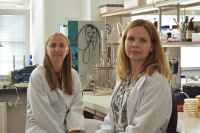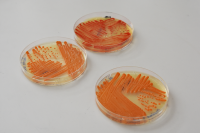Discovering by Budding

Dr hab. Jolanta Mierzejewska i dr inż. Karolina Chreptowicz, założycielki WUT Yeast Collection z Wydziału Chemicznego PW, fot. BPI
The first thing that comes to mind when you hear the word “yeast” is perfectly risen pastry dough, a glass of kefir and – for adults – a beer or glass of wine. However, yeast is a very broad umbrella term for a great diversity of species which offer numerous possibilities far beyond the culinary realm. This fascinating world, invisible to the naked eye, was the topic of our conversation with the researchers behind the WUT Yeast Collection – Jolanta Mierzejewska, Ph.D., and Karolina Chreptowicz, Ph.D., Eng., of the Faculty of Chemistry at the Warsaw University of Technology.
I hear students love your classes.
Jolanta Mierzejewska, Ph.D.: When the general and industrial microbiology lab was founded five years ago, we thought that isolating various organisms from the environment would be an interesting topic for research with students. The idea was actually put into practice. Students have fun working in the field with a swab kit, “patting” trees and returning to the lab with a sample they can test themselves.
What exactly do you extract from such samples?
J.M.: Microorganisms, including yeast. Our goal is to discover those which have interesting biotechnological properties.
This practical approach to yeast was the driving force behind the project which was awarded funding by the National Science Centre in 2016.
J.M.: As part of the project, we started to work on the WUT Yeast Collection. The idea was to find new yeast strains able to produce natural flavors, dyes and polymers. We have managed to isolate more than 230 strains and identify what species they belong to. We investigated their potential for producing dyes and flavors. It turned out that a large number of microorganisms produce a rose flavor. Extracellular polymers are also interesting, as they can be used as additives for healthy foods or cosmetics.
Petri dishes with visible yeast producing carotenoid dyes. Photo: BPI.
What is the process that leads from sampling to strain identification? How do we know we have found what we are looking for?
J.M.: You can collect a sample from virtually anywhere – from a tree, bush, fruit, sourdough or fermented foodstuffs. We know that such a sample will contain a lot of bacteria and microscopic fungi. We can extract yeast from that pool by using selective media. We add antibiotics to the medium to eliminate bacteria and what we are then left with are microscopic fungi – in general, mould and yeast. Then, through microscopic observations, we check whether the cells are nucleated. If they are, we know that we are dealing with fungi and we are close to finding yeast. Then, using biochemical metabolic testing, we get to the bottom of things.
Anyone can provide you with material for such tests?
Karolina Chreptowicz, Ph.D., Eng.: Exactly. It is best if the sample is placed in a clean sterile container. One of our students once went on an expedition to Armenia and Kirgizstan and brought back samples of mare and camel milk. You only need to remember to transport the sample in reasonable conditions and make sure it is legal to export them.
Only such “exotic” samples are interesting?
K.C.: Thanks to our project we know that it is enough to travel across Poland to get valuable material. For example, we have once isolated psychrophilic strains from a sample collected at the Baltic Sea, which is interesting as they usually inhabit regions with lower temperatures, such as the Arctic Sea.
It is one example of unconventional yeast.
J.M.: In the past, the term ”yeast” was only used to denote yeast used for baking, beer brewing, making kefir or wine. It is now described as “conventional” yeast. However, there is also another group – “unconventional yeast”, which is more interesting from a biotechnological perspective. It has only been explored for several decades at most. We find it in water from the Arctic, Antarctic, extreme environments, desert ecosystems and places where the flora seems scarce.
Is yeast a nice research subject to work with?
J.M.: It is virtually the perfect study model. It is cheap and quick to grow and its cells behave like a living organism. It also offers a lot of possibilities. It turns out that cancer cells often behave like fermenting yeast, so this model can be used to study increased gene expression in selected pathological cells. Ongoing research also focuses on neurodegenerative diseases, such as Huntington’s disease. The proteins involved in the onset of the disease symptoms were also identified thanks to yeast.
K.C.: I was among the lucky students who had the opportunity to take part in molecular biology classes taught by Jolanta Mierzejewska, Ph.D., at the Warsaw University of Technology. We added a specific gene and the yeast turned from white to pink, we switched off another gene and the yeast stopped growing on a specific medium. Such results were very rewarding. I did not suspect back then that the classes would be a prelude to my adventure with yeast.
J.M.: Students often motivate us to look at out microorganisms from a different perspective, they contribute fresh insights.
The WUT Yeast Collection is an open database, so students may use it in their own research?
J.M.: They may and they eagerly do it. They often use strains they have isolated themselves.
K.C.: Recently, two students from the Herbion Biotechnology Research Club have used our yeast in the SAMPLE/Igluna project. They added the yeast to soil placed in prototype modules for anaerobic plant culture in moon-like conditions. The yeast was to be used to produce carbon dioxide.
Do you have your own yeast favourites?
J.M.: I would say baker’s yeast, I am especially fond of it. Besides, it keeps surprising me – some strains can for example help to treat candidiases. Candidasis is quite a formidable opponent, especially since the recent appearance of a new pathogenic species, Candida auris, which is immune to all treatments.
K.C.: I also have positive experience with baker’s yeast; it has allowed us to produce the rose flavor. But I also have a soft spot for what is known as red yeast, which produces carotenoid dyes.
--------------
WUT Yeast Collection is a publicly available collection of yeast established at the Chair for the Biotechnology of Medicinal Products and Cosmetics of the Faculty of Chemistry of the Warsaw University of Technology as part of the SONATA 11 project funded by the National Science Centre. The database of systematic names and phenotypical properties of the isolated strains is available for browsing on wutyeastcollection.pw.edu.pl
Safety is an important characteristic of the microorganisms stored in the collection assembled by Jolanta Mierzejewska, Ph.D, and Karolina Chreptowicz, Ph.D., Eng. However, the Warsaw University of Technology should soon offer a space for working with pathogens. Work on opening a special new lab is underway at the CEZAMAT Centre for Advanced Materials and Technologies The space will be open to the entire research community of the Warsaw University of Technology. We will inform you about the opening of the lab in a separate article.








